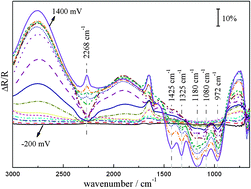In situ infrared (FTIR) study of the mechanism of the borohydride oxidation reaction
Abstract
Early reports stated that ![[small nu, Greek, macron]](https://www.rsc.org/images/entities/i_char_e0ce.gif) ∼ 1180, 1080 and 972 cm−1) and B–O bond regions (
∼ 1180, 1080 and 972 cm−1) and B–O bond regions (![[small nu, Greek, macron]](https://www.rsc.org/images/entities/i_char_e0ce.gif) = 1325 and ∼1425 cm−1), which appear sequentially as a function of the
= 1325 and ∼1425 cm−1), which appear sequentially as a function of the

Maintenance work is planned for Wednesday 1st May 2024 from 9:00am to 11:00am (BST).
During this time, the performance of our website may be affected - searches may run slowly and some pages may be temporarily unavailable. If this happens, please try refreshing your web browser or try waiting two to three minutes before trying again.
We apologise for any inconvenience this might cause and thank you for your patience.
* Corresponding authors
a
Laboratoire d'Electrochimie et de Physico-chimie des Matériaux et des Interfaces (LEPMI) UMR 5631 CNRS/ Université de Grenoble, 1130 Rue de la Piscine, BP75, 38402 Saint Martin d'Hères Cedex, France
E-mail:
Maria-Belen.Molina-Concha@grenoble-inp.fr
Fax: +33 476 82 6777
Tel: +33 4768 26522
b Instituto de Química de São Carlos, Universidade de São Paulo, Av. Trab. São-carlense 400, CP 780, CEP 13560-970, São Carlos, Brazil
c Departamento de Química, Centro Tecnológico, Universidade Federal do Maranhão, Av. dos Portugueses, S/N, Campus do Bacanga, Bacanga, 65085-580 – Sao Luis, MA-Brazil
Early reports stated that ![[small nu, Greek, macron]](https://www.rsc.org/images/entities/i_char_e0ce.gif) ∼ 1180, 1080 and 972 cm−1) and B–O bond regions (
∼ 1180, 1080 and 972 cm−1) and B–O bond regions (![[small nu, Greek, macron]](https://www.rsc.org/images/entities/i_char_e0ce.gif) = 1325 and ∼1425 cm−1), which appear sequentially as a function of the
= 1325 and ∼1425 cm−1), which appear sequentially as a function of the

 Please wait while we load your content...
Something went wrong. Try again?
Please wait while we load your content...
Something went wrong. Try again?
B. M. Concha, M. Chatenet, F. Maillard, E. A. Ticianelli, F. H. B. Lima and R. B. de Lima, Phys. Chem. Chem. Phys., 2010, 12, 11507 DOI: 10.1039/C003652H
To request permission to reproduce material from this article, please go to the Copyright Clearance Center request page.
If you are an author contributing to an RSC publication, you do not need to request permission provided correct acknowledgement is given.
If you are the author of this article, you do not need to request permission to reproduce figures and diagrams provided correct acknowledgement is given. If you want to reproduce the whole article in a third-party publication (excluding your thesis/dissertation for which permission is not required) please go to the Copyright Clearance Center request page.
Read more about how to correctly acknowledge RSC content.
 Fetching data from CrossRef.
Fetching data from CrossRef.
This may take some time to load.
Loading related content
